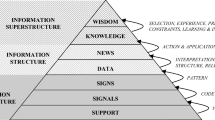Abstract
The purpose of this article is to provide a precise better understanding of the Computing-KnowledgeWorking essence and an overview of the current/future state of its research. The main attention is concentrated on an autopoietic mechanism of the both Computing, and NaturalKnowledgeWorking techniques. The essence of theories of artificial intelligence and soft computing as well as Computing-NaturalKnowledgeWorking phenomenon understanding has been analysed. The innovative approach called “Three information translations”, by means of which it is possible to realize the information chain “The task of end user ... computer program” in automatic mode, is presented. It is proposed to define precisely the vocabulary in the forenamed field.
Preview
Unable to display preview. Download preview PDF.
Similar content being viewed by others
References
Drucker, P.F.: Management Challenges for the 21st Century. Butterworth-Heinemann, London (1999)
Teuscher, C.: The Complete Idiot’s Tutorial to In Theorio, In Silico, and In Vivo Computation. In: The abstract of tutorial of 8th European Conf. on Artificial Life – ecol 2005, September 5-9, 2005, University of Kent, Canterbury, UK (2005), Available at the official website of the Conf. http://www.ecal2005.org
de Kerckchove, D.: The Skin of Culture. Somerville House Books Limited, Toronto, Ontario (1995)
Stroustrup, B.: The Design and Evolution of C++. Addison Wesley Longman, Inc., Amsterdam (1994)
Ingber, D.E.: The Architecture of Life. Scientific American, 30-39 (January 1998)
Lewis, T.: Absorb and Extend: Resistance is Futile! Computer. Innovative Technology for Computer Professionals, 109–113 (May 1997)
Sipper, M.: The Emergence of Cellular Computing. Computer. Innovative Technology for Computer Professionals, 18–26 (July 1999)
Penrose, R.: The Emperor’s New Mind Concerning Computer, Minds, and the Law of Physics. Oxford University Press, Oxford (1989)
Kacprzyk, J.: Fuzzy Sets and Fuzzy Logic. In: Shapiro, S.C. (ed.) Encyclopedia of Artificial Intelligence, 2nd edn., vol. 1, pp. 537–542. John Wiley & Sons, Chichester
Shapiro, S.C.: Artificial Intelligence. In: Shapiro, S.C. (ed.) Encyclopedia of Artificial Intelligence, 2nd edn., vol. 1, pp. 54–57. John Wiley & Sons, Chichester
Van Gulick, R.: Philosophical Questions. In: Shapiro, S.C. (ed.) Encyclopedia of Artificial Intelligence, 2nd edn., vol. 2, pp. 1137–1147. John Willey & Sons, Inc., Chichester
Uspenski, V.A., Semenov, A.L.: Theory of Algorithms: Main Discoveries and Applications. Science Academic Publishing House, Moscow (1987) (in Russian)
Pospelov, G.S.: Artificial Intelligence - Base of Novel Information Technology. Science Academic Publishing House, Moscow (1988) (In Russian)
Kompanets, L.: Giving Birth to Biometrics of Asymmetrical Face. In: Leonid, K. (ed.) Computing, Multimedia and Intelligent Techniques. Special Issue on Live Biometrics and Security, Czestochowa University of Technology, Poland, vol. 1, pp. 19–36 (June 2005)
Kompanets, L.: Biometrics of Asymmetrical Face. In: Zhang, D., Jain, A.K. (eds.) ICBA 2004. LNCS, vol. 3072, pp. 67–73. Springer, Heidelberg (2004)
Kompanets, L.: Counterterrorism-Oriented Psychology and Biometrics Techniques: Part 2/2. Based on Brain Asymmetry, Eyes Fingerprints, Face Asymmetry, and Person Psyche Type Identification Information Techniques. In: Callaos, N., Leonid, K., Junishi, T., Huaqiang, W. (eds.) 7th Intern. Multi-Conf. on Systemics, Cybernetics and Informatics - SCI 2003, Orlando, Florida. Pre-Proceedings of Symposium on the Role of Academy in the War on Terrorism, July 29, 2003, pp. 18–21 (2003)
Leonid, K., Janusz, B., Roman, W.: Pseudo-Entropy Similarity for Human Biometrics. In: Tistarelli, M., Bigun, J., Jain, A.K. (eds.) ECCV 2002. LNCS, vol. 2359, pp. 67–73. Springer, Heidelberg (2002)
Author information
Authors and Affiliations
Editor information
Editors and Affiliations
Rights and permissions
Copyright information
© 2006 Springer-Verlag Berlin Heidelberg
About this paper
Cite this paper
Kompanets, L. (2006). Sketch of Autopoietic Essence of Computing and KnowledgeWorking . In: Rutkowski, L., Tadeusiewicz, R., Zadeh, L.A., Żurada, J.M. (eds) Artificial Intelligence and Soft Computing – ICAISC 2006. ICAISC 2006. Lecture Notes in Computer Science(), vol 4029. Springer, Berlin, Heidelberg. https://doi.org/10.1007/11785231_118
Download citation
DOI: https://doi.org/10.1007/11785231_118
Publisher Name: Springer, Berlin, Heidelberg
Print ISBN: 978-3-540-35748-3
Online ISBN: 978-3-540-35750-6
eBook Packages: Computer ScienceComputer Science (R0)




